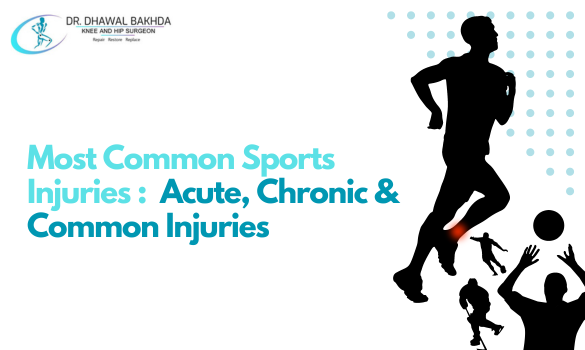
Most Common Sports Injuries - Acute, Chronic & Common Injuries
Sport injuries are a really challenging phase of life for every athlete or sportsperson because it not just affect a person's physical body but also destroy them emotionally or mentally. And sometimes these injuries are seen as the critical culprit behind the ruined careers of many athletes, That’s why these sports injuries should be prevented as soon as it occurs, and it can only be possible with an understanding of these injuries. So, just join us on this blog and get the complete information about sports injuries.
Who Gets Sports Injuries?
Sports injuries can impact anyone, regardless of their background or activity level. Whether you're a seasoned athlete or a beginner, the risk is ever-present. Factors such as improper techniques, overtraining, sudden changes in intensity, and inadequate equipment can heighten this risk. Even prior injuries or anatomical predispositions can increase susceptibility to sports-related harm. So if a professional athlete is performing their regular activity for a long time, that doesn’t mean it can’t happen to them. Sport injuries are harmful for every sportsperson.
Symptoms of Sports Injuries
Recognizing sports injuries relies on identifying their symptoms. Acute injuries, occurring suddenly, may cause: severe pain, swelling, difficulty bearing weight, or visible joint misalignment. Conversely, chronic injuries, resulting from repetitive motion, often entail persistent pain during activity and swelling, with discomfort lingering even during rest.
Note:- Prevent sports injury symptoms from escalating by seeking guidance from a sports injury specialist. Their expertise aids in diagnosing and understanding injuries before they worsen, ensuring timely intervention and effective management to safeguard your well-being and athletic pursuits.
Cause of Sports Injuries
Recognizing the root causes behind sports injuries is crucial for effective treatment and prevention strategies. Acute injuries often arise from sudden impacts surpassing the body's limits, whereas chronic injuries develop from repetitive strain on particular tissues or joints. Intriguingly, continuous overuse can predispose individuals to acute injuries by gradually weakening tissues and undermining joint stability.
Now, let's explore the complex realm of sports injuries, discerning between acute and chronic types while examining common musculoskeletal injuries faced by athletes and active individuals in their pursuit of physical excellence
Types of Musculoskeletal Injuries
Musculoskeletal injuries span a wide range of issues impacting muscles, bones, ligaments, and tendons. They're categorized into acute and chronic types, each demanding distinct treatment strategies and posing varied challenges for effective management and recovery.
Acute Injuries
- Fractures: These involve breaks in bones, occurring either from sudden trauma or repeated stress, as seen in stress fractures and growth plate fractures.
- Dislocations: It happens when joints become displaced due to forceful impacts or excessive stretching, commonly occurring in contact sports or high-impact activities.
- Sprains: Stretching or tearing of ligaments, typically resulting from falls or blows that force joints out of position.
- Tendinitis: Inflammation of tendons from repetitive motion, affecting various joints like the shoulder, elbow, wrist, hip, knee, or ankle.
- Bursitis: Inflammation of bursae, small sacs cushioning bones, commonly caused by repetitive motion or prolonged pressure on joints.
Chronic Injuries
- Rotator Cuff Injury: It’s very common in individuals with overhead occupations or athletes engaging in repetitive upper limb motions.
- Tennis Elbow & Golfer’s Elbow: It results from repetitive wrist and forearm movements, prevalent in sports and professions involving these actions.
- Runner’s Knee: It causes pain around or under the kneecap, often seen in runners or individuals engaging in activities involving knee stress.
- Shin Splints: Inflammation along the inner shinbone due to repetitive impact, common among runners and novice athletes.
- Ankle Sprains: It’s occur from sudden twists or turns, prevalent in activities requiring rapid changes in direction or uneven surfaces.
- Achilles Tendinitis: It results from overuse or strain on the Achilles tendon, often seen in activities involving repetitive calf muscle engagement.
Treatment and Prevention
Treatment approaches for sports injuries differ based on severity and type. Minor injuries may respond to R-I-C-E (rest, ice, compression, elevation), while severe cases may require medical attention, physical therapy, or surgery. Prevention involves proper technique, gradual training, equipment use, and regular conditioning to reduce injury risk.
Conclusion
Sports injuries aren't limited to athletes but affect all those engaging in physical activity. Understanding sport injury types, symptoms, causes, and preventive measures is crucial for ensuring safe fitness practices. Through awareness and precautions, individuals can reduce the risk of harm, fostering long-term health and enjoyment in their active lifestyles. Seeking the best treatment for sports injuries, then look no further than consulting a sports injury doctor such as Dr. Dhawal Bakhda and rejuvenating your sporting skills.
